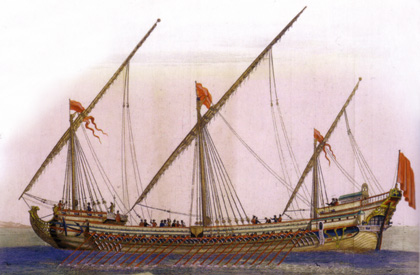Execution by Boat October 11, 2016
Author: Beach Combing | in : Modern , trackback
In the famous nineteenth-century Belgian novel The Legend of Thyl Ulenspiegel and Lamme Goedzak there is a reference to an unexpected form of execution.
‘Since you do not like any of these,’ said the Stevenyne, ‘you shall be taken on to the king’s ships, and there condemned to be torn asunder by four galleys.’
The idea is clear: a man is brought to sea, tied between four boats that then row away ripping his body into fragments. His last impressions will presumably be of floating helplessly down into the depths. Nasty, effective and relatively cheap… Now Ulenspiegel is a joke novel, there is no reason for believing, on this evidence, that this punishment was ever used, but there are some early modern hints (or better hints about that period) that death by ship was occasionally employed.
Ottobuono de’ Fieschi brother of the Genoese conspirator was captured and delivered to Andrea Doria who ordered him to be either torn asunder by four galleys, or sewed up in a sack and cast into the sea! Perhaps both: it was a sacrifice not uncommon in that day, and made to the manes of Giannottino Doria nephew of Andrea, who had fallen in putting down the Fieschi conspiracy! [This in Napier’s Florentine History for 1555]
There is also the claim that dismemberment by ship was employed on the Barbary coast: Olfert Dapper, (1670) Umbstaendliche und eigentliche Beschreibung von Africa. Amsterdam: J. von Meurs. p. 167 (Stolen shamelessly from Wikipedia and unchecked!!!!)
That execution expert Geoffrey Abbott has the following passage, whose source remains elusive about yet another boat execution:
Most executions are harder on the victim than on the executioner, but that can hardly be said for this particular method. Perhaps that is the reason for its being the only instance ever recorded, taking place in 1582 when Spaniards captured a pirate and decided to make the punishment fit the crime. Accordingly, they tied ropes to his wrists and ankles, the other ends being secured to the sterns of small boats. The crews of the vessels then rowed in different directions, thereby dismembering him.
Nigel Cawthorne in Public Executions makes reference to being ‘torn apart between two boats’.
The problem with this list is that none of the references are particularly impressive. The only half convincing source that Beach has come across appears in Hutchinson’s Armada where we read
The master of the ordinance in Naples, who was found guilty of sending a boat full of powder and other munitions to the Queen of England [at the time of the Armada, 1588] on the pretext of forwarding it to Spain’ and [was] sentenced ‘to be torn asunder by four galleys’ rowing in opposite directions (186).
Hutchinson supplies an English reference Fugger Newsletter, 10 November 1588 (1924), 182. The Fuggers were generally accurate, though again Beach has not been able to check the original… Was there really a boat execution in Naples in 1588 or 1589?
Any more proof for this elusive form of killing: drbeachcombing AT yahoo DOT com
David O writes in, 28 Oct 2016, with this contemporary (!) one. “Some were shot, others were tied up with stones and thrown into the sea, and one was ripped apart,” he says. “He hated his captain and tried to beat him to death. But the captain escaped by jumping into the sea. The other captains came and pinned [the fisherman] down. Then they tied up his hands and legs to four separate boats and pulled him apart.” – https://www.theguardian.com/global-development/2014/jun/10/-sp-migrant-workers-new-life-enslaved-thai-fishing


